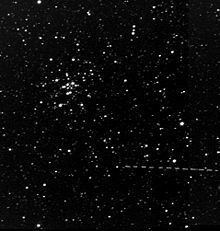Discovered 25 November 1998 | Absolute magnitude 17.9 | |
 | ||
Similar Sun, Solar System, Kepler‑440b, 1566 Icarus, WISE J22460757‑0526350 | ||
(33342) 1998 WT24 is an Aten asteroid with a diameter of about 900 meters, located in Venus's zone of influence that has frequent close encounters with Mercury, Venus, and Earth. It is also one of the best studied potentially hazardous asteroids and was the 10th Aten to be numbered. The asteroid made a close approach to Earth on 11 December 2015, passing at a distance of about 4.2 million kilometers (2.6 million miles, 11 lunar distances) and reaching about apparent magnitude 11.
Contents
Low aphelion
(33342) 1998 WT24 was discovered on November 25, 1998, by LINEAR about four months after a close encounter with the planet Mercury (about 0.047 AU). At the time of its discovery, astronomers were trying to find the first Apohele asteroid (one that is always closer to the Sun than Earth). All asteroids known at the time that got closer to the Sun than Earth also crossed Earth's orbit. Earlier that year, David J. Tholen claimed to have spotted the first Apohele asteroid, which was dubbed 1998 DK36. However, the object was lost without being confirmed. Thus, 1993 DA remained the asteroid with the lowest known aphelion at 1.023 AU. When 1998 WT24 was discovered, it was found to have a slightly smaller aphelion (1.019 AU) than 1993 DA, and was thus the closest thing to an Apohele asteroid known at the time. It lost its smallest aphelion title almost immediately when (415713) 1998 XX2 was discovered only a few weeks later (aphelion = 1.014 AU). Asteroids with even smaller aphelions were discovered until February 2003, when finally, an asteroid with an aphelion smaller than 1.000 AU was discovered. This was 163693 Atira, the first confirmed Apohele asteroid.
Venus zone of influence
1998 WT24 was the second asteroid discovered to be close enough to Venus as to be within the major planet's zone of influence. It is located at about the inner edge of the zone, while (99907) 1989 VA, the first asteroid discovered there, is at about the outer edge. It is possible for planets to capture asteroids located in their sphere of influences into co-orbital relationships such as Trojan and horseshoe asteroids. Because of its frequent close encounters with Mercury and Earth, however, it may prove difficult for Venus to keep 1998 WT24 in a co-orbital relationship for any length of time. Of the six objects in Venus's zone of influence, only one (2002 VE68) is currently a co-orbital.
Record close encounter
1998 WT24 is a Potentially Hazardous Asteroid (PHA). That means its orbit takes it very close to Earth and if it were to collide with our planet, it would cause devastation on at least a regional scale. On December 16, 2001, it became the first Potentially Hazardous Asteroid to be observed passing within 5 Lunar Distances (the average distance between Earth and the Moon) from Earth. Other asteroids have come closer, and numerous have even come closer than the Moon, but these have all been small asteroids, incapable of causing much damage to the planet, or much concern. The 2001 encounter was the closest known approach to Earth any Potentially Hazardous Asteroid had made since (192642) 1999 RD32 passed by on August 27, 1969. However, 1999 RD32 was not discovered until September 1999 many years after its closest approach, so no one knew about 1999 RD32 in 1969.
In September 2004, the well known Potentially Hazardous Asteroid 4179 Toutatis came about 4 Lunar Distances from Earth. Due to its diameter being over ten times larger (5.7 km) and its closer approach, Toutatis at its closest (mag 8.9) was about half an apparent magnitude brighter than 1998 WT24 was at its closest (mag 9.5). However, Toutatis arrived during a full moon, and thus 1998 WT24's 2001 encounter is still the most easily observed flyby of an asteroid in history. It also made 1998 WT24 the first Near-Earth asteroid observed to be brighter than magnitude 10.
Frequent inner-planet encounters
(33342) 1998 WT24 is a Mercury-crosser asteroid, a Venus-crosser asteroid, and an Earth-crosser asteroid. Because of its relatively low inclination (7.34°), it is able to come close to each of these planets. Its orbit takes it within 0.021 AU of Mercury's orbit, 0.0368 AU of Venus's orbit, and 0.00989 AU of Earth's orbit. It makes frequent encounters with these inner planets. The last time it came close to Mercury, Venus and Earth was 2010, 1977, and November 12, 2004 respectively. The most recent close approach to Earth was on 11 December 2015 at about 4.2 million kilometers (2.6 million miles, 11 lunar distances). The next visit of the asteroid to Earth's neighborhood will be on 11 November 2018, when it will make a relatively distant pass at about 20 million kilometers (12.5 million miles, 52 lunar distances). These encounters perturb its orbit parameters slightly, and each pass reduces its inclination further.
Physical characteristics
During its close encounters in 2001 and 2015, astronomers were able to make radar images of its surface and determine physical properties that remain unknown for most asteroids. The asteroid measures 420 by 330 metres (modestly elongated) and completes one rotation every 3.70 hours. It is classified a type E/Xe asteroid.
Future flyby candidate
(33342) 1998 WT24 has an orbit that not only crosses Earth's orbit, but is roughly parallel to it at its furthest. This means that during favourable years it is easy to reach from Earth. Several times this decade, it will be an easier target than Earth's own Moon. It is high on the list of possible Near-Earth Asteroid targets for future flybys, landings, mining, or orbit manipulations.
